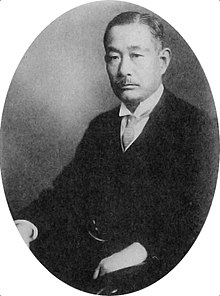Haruji Matsue
| Haruji Matsue | |
|---|---|

Haruji Matsue
|
|
| Born | January 15, 1876 |
| Died | November 29, 1959 (aged 83) |
| Nationality | Japanese |
| Occupation | entrepreneur |
| Known for | Nan’yō Kōhatsu |
Haruji Matsue (松江春次 Matsue Haruji, January 15, 1878 to November 29, 1954) was a Japanese entrepreneur and the first person to manufacture the sugar cube in Japan. His brother, Major General Toyohisa Matsue was commandant of the Bandō prisoner-of-war camp in World War I.
Matsue was born in Aizuwakamatsu, Fukushima as the second son of a former samurai of Aizu Domain. In 1899, he graduated from Tokyo Technical School and found employment with Dai-Nippon Sugar Company. However, in 1903 he passed an acceptance examination held by the Ministry of Agriculture and Commerce and received a scholarship to study overseas. He was sent to the Louisiana State University, well-known at the time for its work in sugar cultivation, and graduated with a master's degree. He returned to Japan in 1907 and was appointed plant manager at Dai-Nippon Sugar’s Osaka factory. However, Matsu left the company in 1908 after it became the center of a public scandal involving the bribery of several noted members of the Diet of Japan and moved to Taiwan. He worked for two sugar companies in Taiwan, but left due to disagreements with their senior management and after realizing that both companied were in precarious financial situations. Visiting Saipan and Tinian in Mariana Islands, he realized their potential for development for sugar cane cultivation, and returned to Japan seeking investors.
Meanwhile, the first governor of South Pacific Mandate, Tezuka Toshiro, was turning to the Oriental Development Company for assistance in reviving the economy of Saipan and rescue the former employees of two failed companies, Nishimura Takushoku and Nan'yō Shokusan. With the capital from these companies and government approval, Matsue acquired the assets of Nan'yō Shokusan. In 1921 he founded Nan’yō Kōhatsu (South Seas Development Company). He trained Japanese laborers living on Saipan and others brought over from Okinawa and the Tōhoku region to clear the land, cultivate and harvest sugar cane, and build his refineries.
...
Wikipedia
